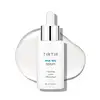What's inside
What's inside
 Key Ingredients
Key Ingredients

 Benefits
Benefits

 Concerns
Concerns

 Ingredients Side-by-side
Ingredients Side-by-side

Water
Skin ConditioningGlycerin
HumectantGlycolic Acid 3.01%
BufferingButylene Glycol
HumectantGluconolactone 3%
Skin ConditioningBetaine
HumectantDipropylene Glycol
HumectantNiacinamide
SmoothingPanthenol 2%
Skin ConditioningPentylene Glycol
Skin ConditioningSodium Hydroxide
BufferingSphingomonas Ferment Extract
Skin ConditioningSodium Hyaluronate
HumectantHydrolyzed Hyaluronic Acid
HumectantHyaluronic Acid
HumectantDiphenyl Dimethicone
EmollientTriethylhexanoin
MaskingHydroxyethyl Urea
HumectantHydroxyethylcellulose
Emulsion StabilisingPolyglyceryl-10 Laurate
Skin ConditioningHydrogenated Lecithin
EmulsifyingCaprylic/Capric Triglyceride
MaskingEthylhexylglycerin
Skin Conditioning1,2-Hexanediol
Skin ConditioningPropanediol
SolventUrea 0.05%
BufferingAdenosine
Skin ConditioningSodium Hyaluronate Crosspolymer
HumectantHydrolyzed Glycosaminoglycans
HumectantCeramide NP 0.01%
Skin ConditioningBenzyl Glycol
SolventBeta-Glucan
Skin ConditioningTocopherol
AntioxidantStearic Acid
CleansingCeramide Ns
Skin ConditioningCholesterol
EmollientPhytosphingosine
Skin ConditioningCeramide AP
Skin ConditioningCeramide As
Skin ConditioningCeramide EOP
Skin ConditioningCetearyl Alcohol
EmollientWater, Glycerin, Glycolic Acid 3.01%, Butylene Glycol, Gluconolactone 3%, Betaine, Dipropylene Glycol, Niacinamide, Panthenol 2%, Pentylene Glycol, Sodium Hydroxide, Sphingomonas Ferment Extract, Sodium Hyaluronate, Hydrolyzed Hyaluronic Acid, Hyaluronic Acid, Diphenyl Dimethicone, Triethylhexanoin, Hydroxyethyl Urea, Hydroxyethylcellulose, Polyglyceryl-10 Laurate, Hydrogenated Lecithin, Caprylic/Capric Triglyceride, Ethylhexylglycerin, 1,2-Hexanediol, Propanediol, Urea 0.05%, Adenosine, Sodium Hyaluronate Crosspolymer, Hydrolyzed Glycosaminoglycans, Ceramide NP 0.01%, Benzyl Glycol, Beta-Glucan, Tocopherol, Stearic Acid, Ceramide Ns, Cholesterol, Phytosphingosine, Ceramide AP, Ceramide As, Ceramide EOP, Cetearyl Alcohol
Water
Skin ConditioningGluconolactone
Skin ConditioningC9-12 Alkane
SolventPropanediol
SolventButylene Glycol
Humectant1,2-Hexanediol
Skin ConditioningTromethamine
BufferingSodium Hydroxide
BufferingSodium Citrate
BufferingCitric Acid
BufferingEthylhexylglycerin
Skin ConditioningVaccinium Myrtillus Fruit Extract
Skin ConditioningAdenosine
Skin ConditioningDisodium EDTA
Saccharum Officinarum Extract
MoisturisingSqualane
EmollientCitrus Aurantium Dulcis Fruit Extract
MaskingCitrus Limon Fruit Extract
MaskingAcer Saccharum Extract
Skin ConditioningDioscorea Japonica Root Extract
Skin ConditioningCorchorus Olitorius Leaf Extract
Skin ConditioningNelumbo Nucifera Root Extract
Skin ConditioningHibiscus Esculentus Fruit Extract
Skin ConditioningAngelica Keiskei Extract
AntioxidantCapryloyl Salicylic Acid
ExfoliatingHippophae Rhamnoides Fruit Oil
Skin ProtectingWater, Gluconolactone, C9-12 Alkane, Propanediol, Butylene Glycol, 1,2-Hexanediol, Tromethamine, Sodium Hydroxide, Sodium Citrate, Citric Acid, Ethylhexylglycerin, Vaccinium Myrtillus Fruit Extract, Adenosine, Disodium EDTA, Saccharum Officinarum Extract, Squalane, Citrus Aurantium Dulcis Fruit Extract, Citrus Limon Fruit Extract, Acer Saccharum Extract, Dioscorea Japonica Root Extract, Corchorus Olitorius Leaf Extract, Nelumbo Nucifera Root Extract, Hibiscus Esculentus Fruit Extract, Angelica Keiskei Extract, Capryloyl Salicylic Acid, Hippophae Rhamnoides Fruit Oil
 Reviews
Reviews

Ingredients Explained
These ingredients are found in both products.
Ingredients higher up in an ingredient list are typically present in a larger amount.
1,2-Hexanediol is a synthetic liquid and another multi-functional powerhouse.
It is a:
- Humectant, drawing moisture into the skin
- Emollient, helping to soften skin
- Solvent, dispersing and stabilizing formulas
- Preservative booster, enhancing the antimicrobial activity of other preservatives
Adenosine is in every living organism. It is one of four components in nucleic acids that helps store our DNA.
Adenosine has many benefits when used. These benefits include hydrating the skin, smoothing skin, and reducing wrinkles. Once applied, adenosine increases collagen production. It also helps with improving firmness and tissue repair.
Studies have found adenosine may also help with wound healing.
In skincare products, Adenosine is usually derived from yeast.
Learn more about AdenosineButylene Glycol (or BG) is used within cosmetic products for a few different reasons:
Overall, Butylene Glycol is a safe and well-rounded ingredient that works well with other ingredients.
Though this ingredient works well with most skin types, some people with sensitive skin may experience a reaction such as allergic rashes, closed comedones, or itchiness.
Learn more about Butylene GlycolEthylhexylglycerin (we can't pronounce this either) is commonly used as a preservative and skin softener. It is derived from glyceryl.
You might see Ethylhexylglycerin often paired with other preservatives such as phenoxyethanol. Ethylhexylglycerin has been found to increase the effectiveness of these other preservatives.
Gluconolactone is a PHA. PHAs are a great gentle alternative to traditional AHAs.
When applied, Gluconolactone has the same affect on skin as AHAs such as lactic acid. It helps dissolve the dead skin cells in the top layer of your skin. This improves texture and brightens the skin.
PHAs are more gentle than AHAs due to their larger structure. They do not penetrate as deeply as AHAs and take a longer time to dissolve dead cells. Studies show PHAs do not cause as much irritation.
Gluconolactone has some interesting properties:
In a 2004 study, Gluconolactone was found to prevent UV damage in mouse skin cells and has not been found to increase sun sensitivity. However, we still recommend wearing SPF daily.
This ingredient is is an created by reacting gluconic acid with an alcohol.
Learn more about GluconolactonePropanediol is an all-star ingredient. It softens, hydrates, and smooths the skin.
It’s often used to:
Propanediol is not likely to cause sensitivity and considered safe to use. It is derived from corn or petroleum with a clear color and no scent.
Learn more about PropanediolSodium Hydroxide is also known as lye or caustic soda. It is used to adjust the pH of products; many ingredients require a specific pH to be effective.
In small amounts, sodium hydroxide is considered safe to use. However, large amounts may cause chemical burns due to its high alkaline.
Your skin has a natural pH and acid mantle. This acid mantle helps prevent harmful bacteria from breaking through. The acid mantle also helps keep your skin hydrated.
"Alkaline" refers to a high pH level. A low pH level would be considered acidic.
Learn more about Sodium HydroxideWater. It's the most common cosmetic ingredient of all. You'll usually see it at the top of ingredient lists, meaning that it makes up the largest part of the product.
So why is it so popular? Water most often acts as a solvent - this means that it helps dissolve other ingredients into the formulation.
You'll also recognize water as that liquid we all need to stay alive. If you see this, drink a glass of water. Stay hydrated!
Learn more about Water